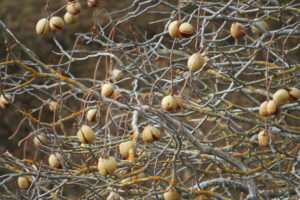Aesculus californica (California Buckeye) is an attractive California native tree that we think is a prize in the garden. We've chosen to share it with you as we think it ought to be more popular. California Buckeye is a small deciduous tree or shrub that packs a showy punch. Starting in late spring, white to creamy pink upright clusters of flowers 6-12 inches long show up. Boy, do they provide a dazzling display! Flowers have a sweet scent that bees and butterflies are also attracted to. The tree is toxic and, unfortunately, pollinators that are not native to California are susceptible. Good news is, deer and gophers stay away for the most part. California buckeye is native to the Central Coast ranges and the Sierra Nevadas below 4,000 feet elevation. Plant it in areas that
receive full sun to light shade. California buckeyes have low water requirements, but will go deciduous in extra dry or hot summers. Once established, you can expect to water it little to never in average rain years.
The California buckeye tree will tolerate difficult clay and serpentine soils. It can also handle seasonal flooding (in nature, you'll often see the tree next to a source of moisture like a creek or spring). California buckeye can grow to 20' tall and 30' or wider, but will typically stay around 15' in the garden. Its silver trunk/multi-trunk and branches make up a lovely silhouette when leaves have dropped, making it a nice option for deciduous trees. It also boasts interesting velvety nut shell
that splits to reveal a glossy seed.
This native horsechestnut favors plant communities found in California like Coastal Sage Scrub, Central Oak Woodland, and Riparian areas.
Take a cue from the California landscape, and bring this beautiful tree into your yard for a strong spring display.










Covid-19 Business Status
All Seasons Landscaping
Covid-19 Business Status
Steve Lake
September Plant of the Month: Leucospermum 'Scarlet Ribbon'
All Seasons Landscaping